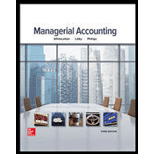
MANAGERIAL ACCOUNTING >C<
3rd Edition
ISBN: 9781259948503
Author: Whitecotton
Publisher: MCG CUSTOM
expand_more
expand_more
format_list_bulleted
Concept explainers
Question
Chapter 2, Problem 11ME
To determine
Concept introduction:
Work in Progress inventory means the stock which is still in the process of production.
Finished Goods inventory means those goods on which the work of production is completed and they are available for sale.
Cost of goods sold means calculate the amount of cost on that inventory which is sold in the market.
Manufacturing
To prepare:
All Necessary Journal Entries of company’s payroll costs and Pass
Expert Solution & Answer
Want to see the full answer?
Check out a sample textbook solution
Students have asked these similar questions
Using the P/E multiples approach to valuation
Solve with explanation and accounting question
Saint Hill Inc. recorded a loss of $9,800 when it sold a van that originally cost $87,000 for $14,300. Accumulated depreciation on the van must have been__.
Chapter 2 Solutions
MANAGERIAL ACCOUNTING >C<
Ch. 2 - What is the difference between job order and...Ch. 2 - What types of companies are likely to use job...Ch. 2 - What types companies are likely to use process...Ch. 2 - Many service industries use job order costing to...Ch. 2 - Prob. 5QCh. 2 - Prob. 6QCh. 2 - Prob. 7QCh. 2 - Prob. 8QCh. 2 - Prob. 9QCh. 2 - Prob. 10Q
Ch. 2 - Prob. 11QCh. 2 - Prob. 12QCh. 2 - Prob. 13QCh. 2 - Prob. 14QCh. 2 - Prob. 15QCh. 2 - Prob. 16QCh. 2 - Prob. 17QCh. 2 - Prob. 18QCh. 2 - Prob. 19QCh. 2 - Prob. 20QCh. 2 - Prob. 21QCh. 2 - Prob. 1MCCh. 2 - Prob. 2MCCh. 2 - Prob. 3MCCh. 2 - Prob. 4MCCh. 2 - Prob. 5MCCh. 2 - Prob. 6MCCh. 2 - Prob. 7MCCh. 2 - Applied overhead costs are recorded a. On the left...Ch. 2 - Prob. 9MCCh. 2 - Prob. 10MCCh. 2 - Identifying Companies That Use Job Order versus...Ch. 2 - Prob. 2MECh. 2 - Prob. 3MECh. 2 - Prob. 4MECh. 2 - Prob. 5MECh. 2 - Prob. 6MECh. 2 - Prob. 7MECh. 2 - Prob. 8MECh. 2 - Prob. 9MECh. 2 - Prob. 10MECh. 2 - Prob. 11MECh. 2 - Calculating Over- or Underapplied Overhead Costs...Ch. 2 - Prob. 13MECh. 2 - Prob. 14MECh. 2 - Prob. 15MECh. 2 - Calculating Direct Materials Used in Production...Ch. 2 - Calculating Missing Amounts and Cost or Goods...Ch. 2 - Prob. 19MECh. 2 - Prob. 1ECh. 2 - Preparing Journal Entries Refer to the information...Ch. 2 - Prob. 3ECh. 2 - Preparing Journal Entries Refer to the information...Ch. 2 - Prob. 5ECh. 2 - Finding Unknown Values in the Cost of Goods...Ch. 2 - Prob. 7ECh. 2 - Prob. 8ECh. 2 - Prob. 9ECh. 2 - Prob. 10ECh. 2 - Calculating the Cost of Finished and Unfinished...Ch. 2 - Computing Overhead Rate and Billing Rate for...Ch. 2 - Prob. 13ECh. 2 - Prob. 14ECh. 2 - Prob. 15ECh. 2 - Prob. 16ECh. 2 - Prob. 17ECh. 2 - Prob. 18ECh. 2 - Prob. 19ECh. 2 - Prob. 20ECh. 2 - Prob. 21ECh. 2 - Preparing Journal Entries Floyds Auto Repair Shop...Ch. 2 - Applying Job Order Costing in a Service Setting...Ch. 2 - Prob. 24ECh. 2 - Prob. 1.1GAPCh. 2 - Prob. 1.2GAPCh. 2 - Prob. 1.3GAPCh. 2 - Prob. 1.4GAPCh. 2 - Prob. 1.5GAPCh. 2 - Preparing Journal Entries Refer to the information...Ch. 2 - Prob. 3.1GAPCh. 2 - Prob. 3.2GAPCh. 2 - Prob. 3.3GAPCh. 2 - Prob. 3.4GAPCh. 2 - Prob. 3.5GAPCh. 2 - Prob. 4.1GAPCh. 2 - Prob. 4.2GAPCh. 2 - Prob. 4.3GAPCh. 2 - Prob. 5.1GAPCh. 2 - Prob. 5.2GAPCh. 2 - Recording Manufacturing Costs and Analyzing...Ch. 2 - Prob. 5.4GAPCh. 2 - Prob. 6GAPCh. 2 - Prob. 7.1GAPCh. 2 - Prob. 7.2GAPCh. 2 - Prob. 7.3GAPCh. 2 - Prob. 7.4GAPCh. 2 - Prob. 7.5GAPCh. 2 - Prob. 8.1GAPCh. 2 - Prob. 8.2GAPCh. 2 - Prob. 8.3GAPCh. 2 - Prob. 8.4GAPCh. 2 - Prob. 8.5GAPCh. 2 - Prob. 1.1GBPCh. 2 - Prob. 1.2GBPCh. 2 - Prob. 1.3GBPCh. 2 - Prob. 1.4GBPCh. 2 - Prob. 1.5GBPCh. 2 - Prob. 2GBPCh. 2 - Prob. 3.1GBPCh. 2 - Prob. 3.2GBPCh. 2 - Prob. 3.3GBPCh. 2 - Prob. 3.4GBPCh. 2 - Prob. 3.5GBPCh. 2 - Prob. 4.1GBPCh. 2 - Prob. 4.2GBPCh. 2 - Prob. 4.3GBPCh. 2 - Recording Manufacturing Costs and Analyzing...Ch. 2 - Recording Manufacturing Costs and Analyzing...Ch. 2 - Recording Manufacturing Costs and Analyzing...Ch. 2 - Prob. 5.4GBPCh. 2 - Prob. 6GBPCh. 2 - Prob. 7.1GBPCh. 2 - Prob. 7.2GBPCh. 2 - Prob. 7.3GBPCh. 2 - Prob. 7.4GBPCh. 2 - Prob. 7.5GBPCh. 2 - Prob. 8.1GBPCh. 2 - Prob. 8.2GBPCh. 2 - Prob. 8.3GBPCh. 2 - Prob. 8.4GBPCh. 2 - Prob. 8.5GBP
Knowledge Booster
Learn more about
Need a deep-dive on the concept behind this application? Look no further. Learn more about this topic, accounting and related others by exploring similar questions and additional content below.Similar questions
arrow_back_ios
SEE MORE QUESTIONS
arrow_forward_ios
Recommended textbooks for you
- Principles of Accounting Volume 2AccountingISBN:9781947172609Author:OpenStaxPublisher:OpenStax College
 Principles of Cost AccountingAccountingISBN:9781305087408Author:Edward J. Vanderbeck, Maria R. MitchellPublisher:Cengage Learning
Principles of Cost AccountingAccountingISBN:9781305087408Author:Edward J. Vanderbeck, Maria R. MitchellPublisher:Cengage Learning College Accounting, Chapters 1-27AccountingISBN:9781337794756Author:HEINTZ, James A.Publisher:Cengage Learning,
College Accounting, Chapters 1-27AccountingISBN:9781337794756Author:HEINTZ, James A.Publisher:Cengage Learning,

Principles of Accounting Volume 2
Accounting
ISBN:9781947172609
Author:OpenStax
Publisher:OpenStax College

Principles of Cost Accounting
Accounting
ISBN:9781305087408
Author:Edward J. Vanderbeck, Maria R. Mitchell
Publisher:Cengage Learning

College Accounting, Chapters 1-27
Accounting
ISBN:9781337794756
Author:HEINTZ, James A.
Publisher:Cengage Learning,
Cost Accounting - Definition, Purpose, Types, How it Works?; Author: WallStreetMojo;https://www.youtube.com/watch?v=AwrwUf8vYEY;License: Standard YouTube License, CC-BY